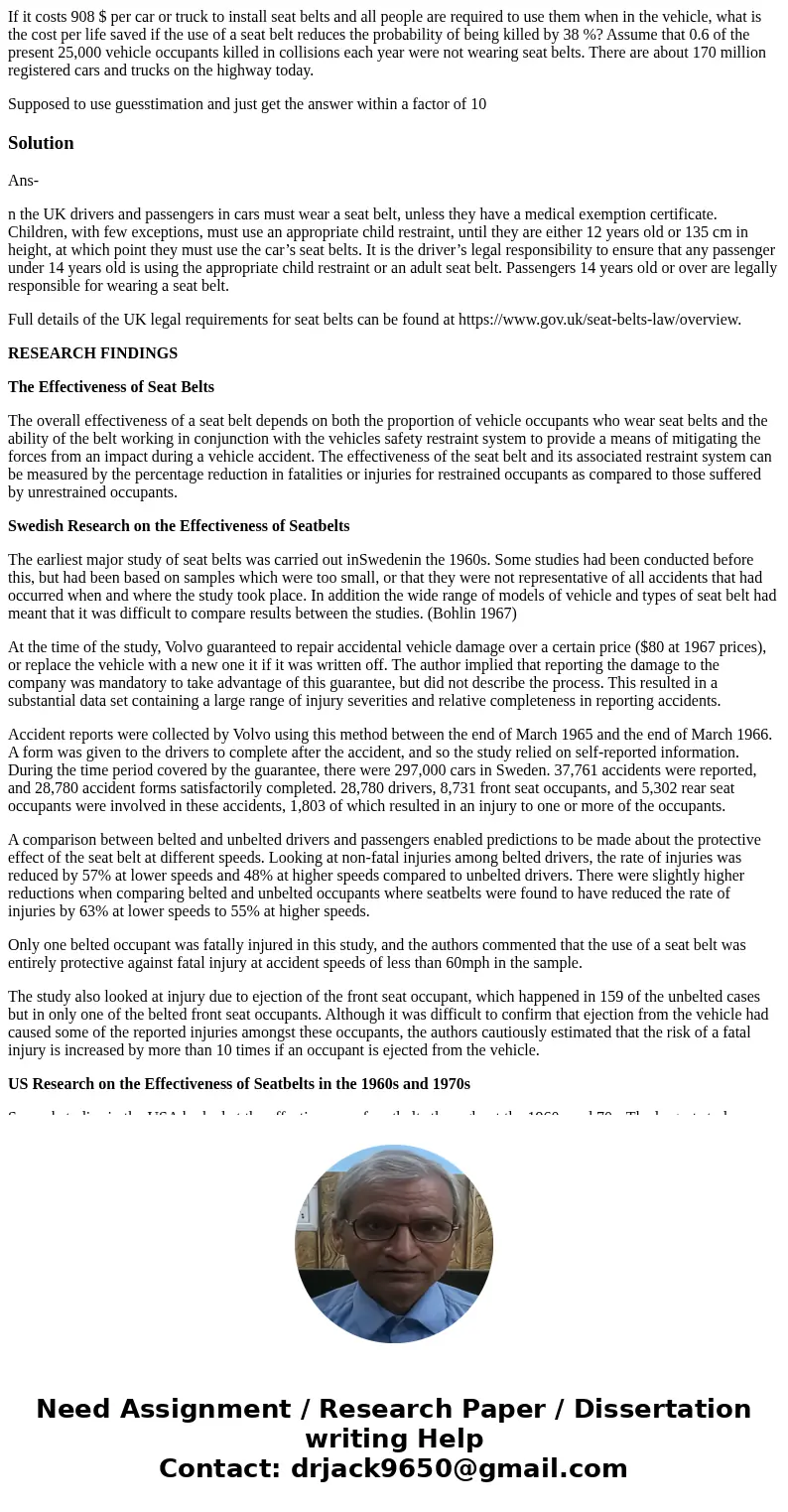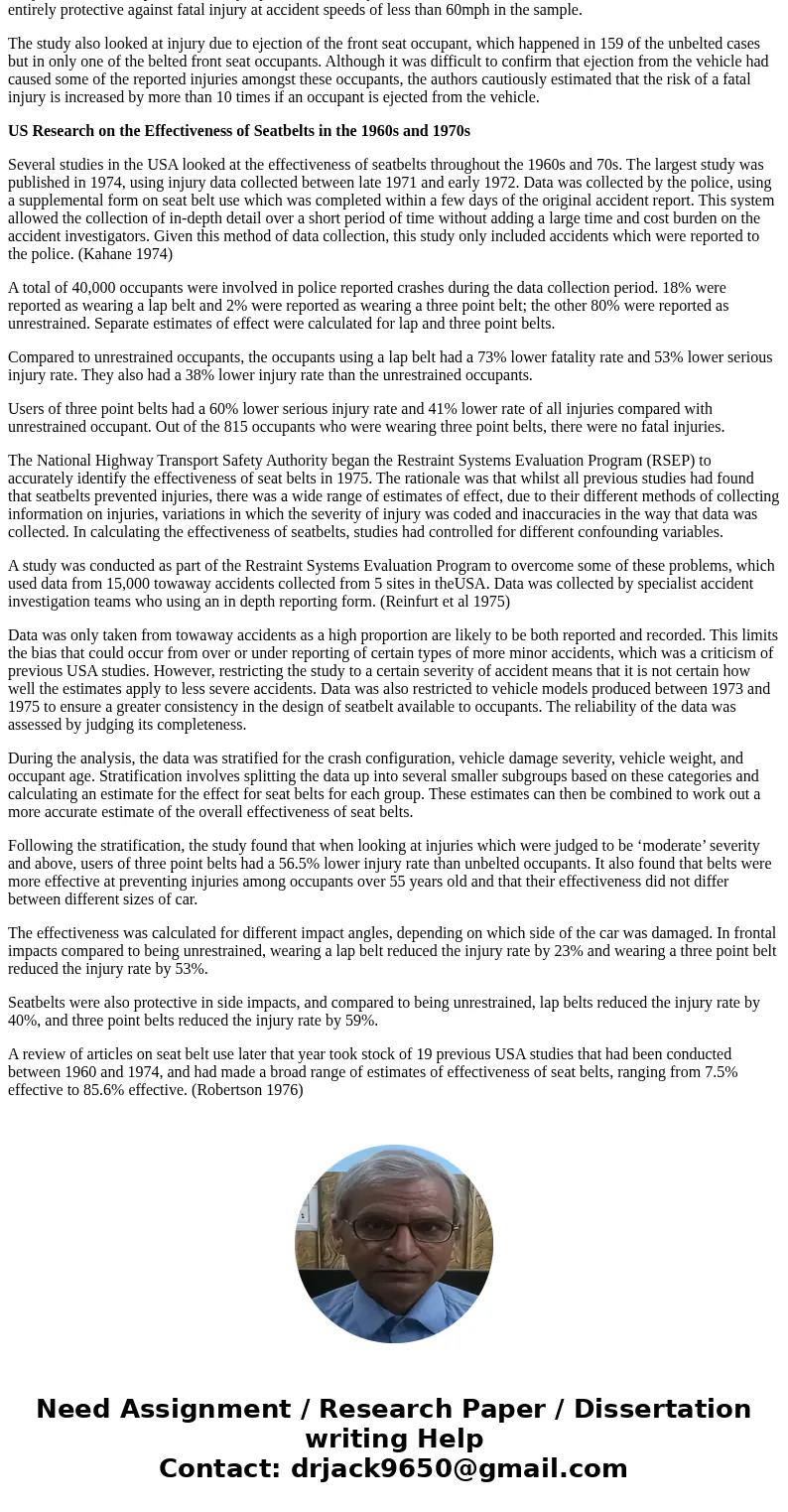If it costs 908 per car or truck to install seat belts and
If it costs 908 $ per car or truck to install seat belts and all people are required to use them when in the vehicle, what is the cost per life saved if the use of a seat belt reduces the probability of being killed by 38 %? Assume that 0.6 of the present 25,000 vehicle occupants killed in collisions each year were not wearing seat belts. There are about 170 million registered cars and trucks on the highway today.
Supposed to use guesstimation and just get the answer within a factor of 10
Solution
Ans-
n the UK drivers and passengers in cars must wear a seat belt, unless they have a medical exemption certificate. Children, with few exceptions, must use an appropriate child restraint, until they are either 12 years old or 135 cm in height, at which point they must use the car’s seat belts. It is the driver’s legal responsibility to ensure that any passenger under 14 years old is using the appropriate child restraint or an adult seat belt. Passengers 14 years old or over are legally responsible for wearing a seat belt.
Full details of the UK legal requirements for seat belts can be found at https://www.gov.uk/seat-belts-law/overview.
RESEARCH FINDINGS
The Effectiveness of Seat Belts
The overall effectiveness of a seat belt depends on both the proportion of vehicle occupants who wear seat belts and the ability of the belt working in conjunction with the vehicles safety restraint system to provide a means of mitigating the forces from an impact during a vehicle accident. The effectiveness of the seat belt and its associated restraint system can be measured by the percentage reduction in fatalities or injuries for restrained occupants as compared to those suffered by unrestrained occupants.
Swedish Research on the Effectiveness of Seatbelts
The earliest major study of seat belts was carried out inSwedenin the 1960s. Some studies had been conducted before this, but had been based on samples which were too small, or that they were not representative of all accidents that had occurred when and where the study took place. In addition the wide range of models of vehicle and types of seat belt had meant that it was difficult to compare results between the studies. (Bohlin 1967)
At the time of the study, Volvo guaranteed to repair accidental vehicle damage over a certain price ($80 at 1967 prices), or replace the vehicle with a new one it if it was written off. The author implied that reporting the damage to the company was mandatory to take advantage of this guarantee, but did not describe the process. This resulted in a substantial data set containing a large range of injury severities and relative completeness in reporting accidents.
Accident reports were collected by Volvo using this method between the end of March 1965 and the end of March 1966. A form was given to the drivers to complete after the accident, and so the study relied on self-reported information. During the time period covered by the guarantee, there were 297,000 cars in Sweden. 37,761 accidents were reported, and 28,780 accident forms satisfactorily completed. 28,780 drivers, 8,731 front seat occupants, and 5,302 rear seat occupants were involved in these accidents, 1,803 of which resulted in an injury to one or more of the occupants.
A comparison between belted and unbelted drivers and passengers enabled predictions to be made about the protective effect of the seat belt at different speeds. Looking at non-fatal injuries among belted drivers, the rate of injuries was reduced by 57% at lower speeds and 48% at higher speeds compared to unbelted drivers. There were slightly higher reductions when comparing belted and unbelted occupants where seatbelts were found to have reduced the rate of injuries by 63% at lower speeds to 55% at higher speeds.
Only one belted occupant was fatally injured in this study, and the authors commented that the use of a seat belt was entirely protective against fatal injury at accident speeds of less than 60mph in the sample.
The study also looked at injury due to ejection of the front seat occupant, which happened in 159 of the unbelted cases but in only one of the belted front seat occupants. Although it was difficult to confirm that ejection from the vehicle had caused some of the reported injuries amongst these occupants, the authors cautiously estimated that the risk of a fatal injury is increased by more than 10 times if an occupant is ejected from the vehicle.
US Research on the Effectiveness of Seatbelts in the 1960s and 1970s
Several studies in the USA looked at the effectiveness of seatbelts throughout the 1960s and 70s. The largest study was published in 1974, using injury data collected between late 1971 and early 1972. Data was collected by the police, using a supplemental form on seat belt use which was completed within a few days of the original accident report. This system allowed the collection of in-depth detail over a short period of time without adding a large time and cost burden on the accident investigators. Given this method of data collection, this study only included accidents which were reported to the police. (Kahane 1974)
A total of 40,000 occupants were involved in police reported crashes during the data collection period. 18% were reported as wearing a lap belt and 2% were reported as wearing a three point belt; the other 80% were reported as unrestrained. Separate estimates of effect were calculated for lap and three point belts.
Compared to unrestrained occupants, the occupants using a lap belt had a 73% lower fatality rate and 53% lower serious injury rate. They also had a 38% lower injury rate than the unrestrained occupants.
Users of three point belts had a 60% lower serious injury rate and 41% lower rate of all injuries compared with unrestrained occupant. Out of the 815 occupants who were wearing three point belts, there were no fatal injuries.
The National Highway Transport Safety Authority began the Restraint Systems Evaluation Program (RSEP) to accurately identify the effectiveness of seat belts in 1975. The rationale was that whilst all previous studies had found that seatbelts prevented injuries, there was a wide range of estimates of effect, due to their different methods of collecting information on injuries, variations in which the severity of injury was coded and inaccuracies in the way that data was collected. In calculating the effectiveness of seatbelts, studies had controlled for different confounding variables.
A study was conducted as part of the Restraint Systems Evaluation Program to overcome some of these problems, which used data from 15,000 towaway accidents collected from 5 sites in theUSA. Data was collected by specialist accident investigation teams who using an in depth reporting form. (Reinfurt et al 1975)
Data was only taken from towaway accidents as a high proportion are likely to be both reported and recorded. This limits the bias that could occur from over or under reporting of certain types of more minor accidents, which was a criticism of previous USA studies. However, restricting the study to a certain severity of accident means that it is not certain how well the estimates apply to less severe accidents. Data was also restricted to vehicle models produced between 1973 and 1975 to ensure a greater consistency in the design of seatbelt available to occupants. The reliability of the data was assessed by judging its completeness.
During the analysis, the data was stratified for the crash configuration, vehicle damage severity, vehicle weight, and occupant age. Stratification involves splitting the data up into several smaller subgroups based on these categories and calculating an estimate for the effect for seat belts for each group. These estimates can then be combined to work out a more accurate estimate of the overall effectiveness of seat belts.
Following the stratification, the study found that when looking at injuries which were judged to be ‘moderate’ severity and above, users of three point belts had a 56.5% lower injury rate than unbelted occupants. It also found that belts were more effective at preventing injuries among occupants over 55 years old and that their effectiveness did not differ between different sizes of car.
The effectiveness was calculated for different impact angles, depending on which side of the car was damaged. In frontal impacts compared to being unrestrained, wearing a lap belt reduced the injury rate by 23% and wearing a three point belt reduced the injury rate by 53%.
Seatbelts were also protective in side impacts, and compared to being unrestrained, lap belts reduced the injury rate by 40%, and three point belts reduced the injury rate by 59%.
A review of articles on seat belt use later that year took stock of 19 previous USA studies that had been conducted between 1960 and 1974, and had made a broad range of estimates of effectiveness of seat belts, ranging from 7.5% effective to 85.6% effective. (Robertson 1976)


 Homework Sourse
Homework Sourse